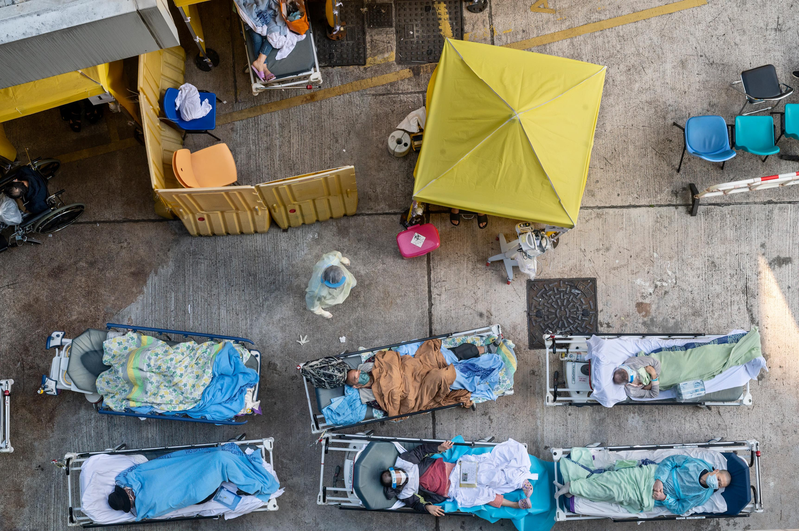- Forty-six sudden deaths leave community in shock
- New BA.2 strain producing worrying results in trials
- Health officials’ worst fears have emerged in densely populated city
A KILLER HAS COME TO TOWN. In Hong Kong, 46 lives have been snatched at high speed by a strain of Covid in a shocked city which has been astonishingly free of such deaths since last summer.
The BA.2 variant of Omicron is now airborne in the city, and is spreading quickly and invisibly. It has been confirmed as more transmissible than any strain before it—and may be as deadly as Delta, according to the results of one new study.
Yet scientists are cautious – the new paper contradicts other studies, and is a pre-print, which means it has not been peer-reviewed. Yet it comes from a highly respected lab in Japan, known for getting things right.
A second study has also raised concern, indicating that BA.2 is resistant to major treatments.
Given these concerns, there are calls for a new name for the variant. In the Greek alphabet naming system, a new strain would be called Pi, Rho or Sigma.
SUDDENLY, MANY DIE
The sudden rash of deaths has caused a shock in Hong Kong, proud of its almost uniquely successful fight against Covid so far, with no deaths at all for half a year, and very few of the “long covid” issues that have bedevilled populations in the UK and elsewhere.
And what is making it even more worrying for residents is that that Hong Kong victims span the age groups, from a man aged 100 to people in their 30s, and all the way down to children aged three and four.

One of the most densely populated places on earth, the Hong Kong community has worked hard to keep the disease out, knowing that its spread, if and when it started, would be fast and unstoppable.
The disease did make attempts to break the wall, sneaking in with flight attendants exploiting their exemption from regular quarantine restrictions, and hiding in the respiratory ducts of hamsters imported from the Netherlands. The populace, patient by nature, and more prone to mask-wearing and being cautious than many foreigners, made a brave effort to prevent a serious Covid outbreak for most of the two-year history of the disease: but the odds were stacked against it.
PENETRATING THE WALL
Here are the facts:
Omicron was first identified in South Africa late last year and spread to the UK and Hong Kong on the same day, December 11. In the UK, it spread fast, killing thousands of people. While less deadly, its increased transmissibility meant that it could ultimately cause more deaths than Delta – and has done so in several places.
In Hong Kong that December day, Omicron was quickly isolated and wiped out by the city’s tough border controls.
But in January, it slipped into Hong Kong again, this time managing to break through the safeguards and reach the population.
The city’s covid death count, which had been kept down at 213 since July of last year, suddenly started to climb, jumping by 46 to 259 at the latest count, today.
“BA.2 is very different from Alpha, Beta, Gamma, Delta, and even Omicron, which is why some researchers are calling for a new name.”
BA.2 IS DIFFERENT
Under the microscope, the BA.2 subvariant looks very different from the original Covid virus which started killing people in December of 2019 in Wuhan in China and in Kansas in the United States (the first registered deaths from the disease happened in both places on the same day).
Numerous genetic changes means BA.2 is very different from Alpha, Beta, Gamma, Delta, and even Omicron, which is why some researchers are calling for a new name.
ATTACKS THE LUNGS
One of the worrying new studies comes from the University of Tokyo. Here’s what it shows.
- BA.2 is faster in copying itself in cells more than BA.1, the original version of Omicron.
- It’s better at making cells clump together to form clusters known as syncytia – a lung-ripping skill associated with the deadly strain Delta.
- It is resistant to monoclonal antibody treatments.
- When Tokyo researchers infected hamsters with BA.2 and BA.1, the animals infected with BA.2 became more ill and suffered worse lung damage.
The lead investigator in the Tokyo study, Kei Sato, argues that BA.2 is not regular Omicron and needs to be watched carefully.
DEATHS UP OR DOWN?
What’s the next step? Scientists note that the Tokyo research was done on animals, and what harms hamsters may not harm humans. So what can we learn from looking at human results in the field? When BA.2 pushes out Delta or the original Omicron, do death rates go down or up?
In most places, they go down, preliminary results suggest. But in some places, they move up, as in the United States – another case in point is Denmark. In that small country, BA.2 is the top strain infecting the public, and hospitalizations and deaths have risen.
It is not known what causes this. A further complicating factor is that BA.2 itself comes in various types, with the ones in Denmark (and in Hong Kong) not being identical to the ones in the Philippines and other places.

RESISTS DRUGS
Separately, studies in the US show that BA.2 strongly resists some antibody treatments. New drugs, including one named Sotrovimab, have been launched in that country.
But how strong are they? Reuters reported that David Ho of Columbia University said experiments showed that Sotrovimab did have some level of activity against BA.2. “But its activity is down substantially, 27-fold as stated in our preprint.”
After the paper was submitted to a preprint site, he tried the experiments again, and found the effectiveness was even lower, he said.
HK AS GUINEA PIG
The powerful contrast between Hong Kong’s long covid-free status and its sudden acquisition of a worrying strain, has been identified as a learning opportunity for science.

Up to now, questions about the transmissibility of BA.2 are hard to answer because almost all communities have a mixture of people who are infected and/ or vaccinated.
Research needs clearer demarcations between a BA.2-free community and one which has acquired the disease if it wants to draw clear conclusions.
“But it turns out there is a place where clear answers to key questions may be within reach — if that place is really, really unlucky,” said Helen Branswell of Stat, a medical journal. “That place is Hong Kong.”
Nury Vittachi is editor of Fridayeveryday, a Hong Kong-based journalist and author, who gained fame through his witty comedy-news writing. His work does not just make you laugh, but reflect.
The story was first published on Fridayeveryday, and is reprinted in truereport.hk with the consent of the author.